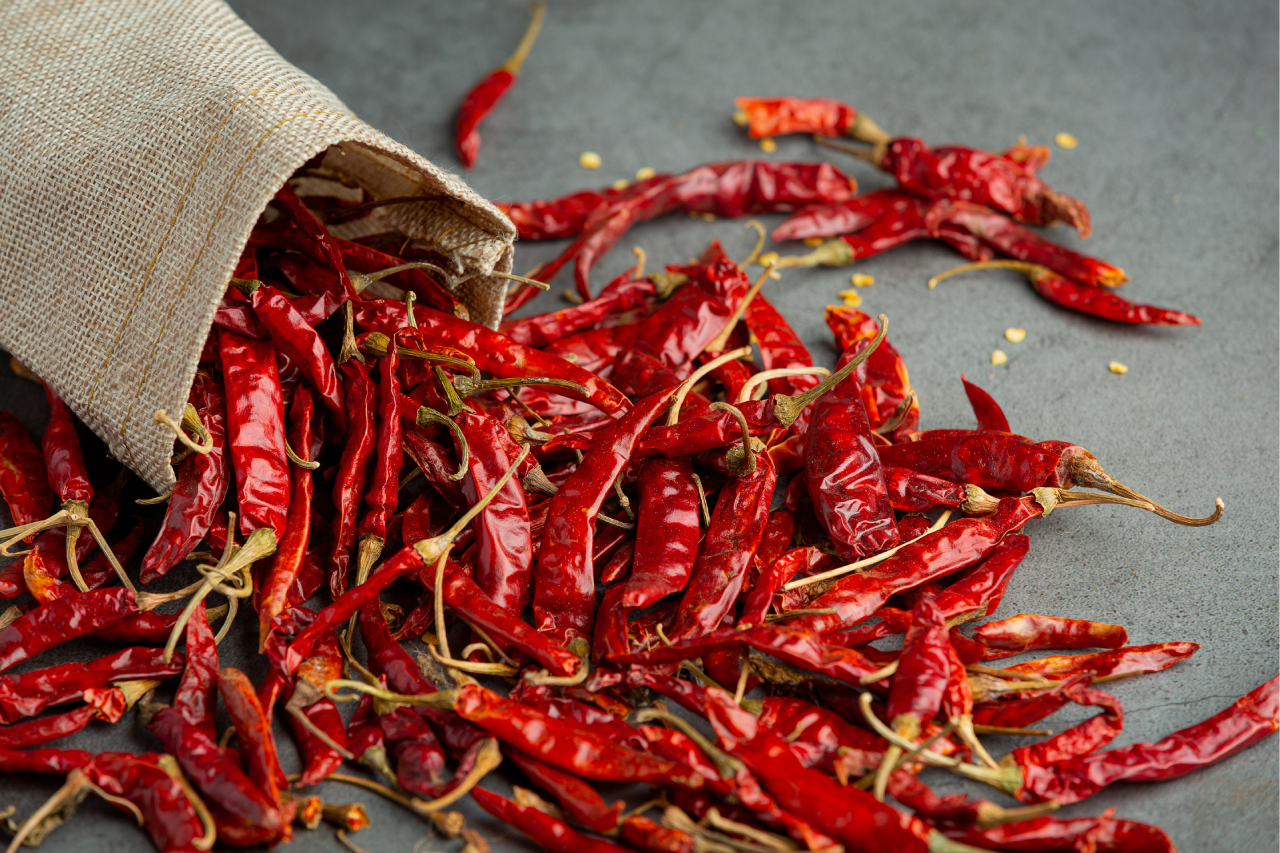India is the largest producer and exporter of red chillies in the world, accounting for more than 40% of global chilli exports. With its vast Agroclimatic zones and centuries-old cultivation practices, India offers a wide range of chilli varieties, each with distinct pungency, colour, and aroma profiles. However, sourcing consistently high-quality red chillies in bulk from India is both an opportunity and a challenge. To secure the right product and supplier, buyers need a deep understanding of the supply chain, production regions, quality standards, and logistics.
This guide walks you through the key aspects of sourcing bulk red chillies from India helping you ensure consistent quality, reliable supply, and long-term business partnerships.
Understand the Major Chilli Growing Regions
India’s chilli-growing belt spans across Andhra Pradesh, Telangana, Karnataka, Tamil Nadu, Maharashtra, Gujarat, and Rajasthan. Among these:
- Andhra Pradesh and Telangana are known for Guntur chillies, Byadgi, and Teja varieties.
- Karnataka is famous for the Byadgi variety, known for its deep red colour and low pungency.
- Rajasthan and Gujarat produce high-heat varieties suitable for extraction and spice blends.
Each region has its peak harvesting period, soil conditions, and weather variations that impact chilli characteristics. Knowing the source region is the first step to understanding the kind of red chilli you will receive whether you need high capsaicin content, bright red colour, or long shelf life.
Choose the Right Variety for Your Market Needs
Different markets and industries require different types of chillies. Here are some of the most common Indian red chilli varieties for bulk sourcing:
- Teja Chilli: Extremely pungent, used in spice blends and sauces.
- Byadgi Chilli: Low pungency, high in natural red colour (ideal for colouring agents).
- Guntur Sannam (S4): Balanced heat and colour, widely used in the food processing industry.
- 273 Wrinkle Chilli: Deep red colour, good shelf life, medium heat.
- Mundu Chilli: Round, pungent, used in traditional cooking in South India.
Make sure your supplier knows your end use whether it’s for whole dried chilli sales, powdering, oleoresin extraction, or food manufacturing.
Decide Between Whole Chillies and Processed Products
- Whole dried red chillies
- Stemless chillies
- Chilli powder
- Crushed chilli flakes
- Chilli seeds for oil extraction
- Chilli paste or puree (for processing units)
For export buyers and industrial users, the decision depends on factors such as storage conditions, processing capabilities, and value-added requirements.
Check for Quality Parameters and Grading
Consistency in quality starts with setting clear specifications. Indian chillies are graded based on parameters like:
- Pungency (measured in SHU – Scoville Heat Units)
- Moisture content (should ideally be below 12%)
- Colour value (ASTA units) for export-oriented buyers
- Pod length, seed content, and skin texture
- Presence of foreign material, damaged pods, or fungal growth
Work with suppliers or processors who conduct regular lab testing and offer batch-wise reports. Reputable exporters often work with SGS, Intertek, or Spice Board labs for quality assurance.
Work with Reputed Exporters and Processors
To ensure consistent quality, you need to build a long-term relationship with trusted exporters or processors who:
- Source directly from farms or farmer producer organisations (FPOs)
- Have in-house grading, cleaning, and packaging facilities
- Can provide custom specifications based on your needs
- Understand international food safety standards
SpicesIndia.net, for instance, is one such trusted Indian exporter of red chillies with decades of experience in procurement, quality control, and export documentation.
Understand Seasonality and Storage Impact
Red chillies are typically harvested once a year between February and May, depending on the region. If you are sourcing bulk quantities, especially off-season (August to December), storage quality becomes critical.
Ask your supplier about:
- Cold storage options to preserve colour and freshness
- Fumigation and pest control practices
- Packaging standards to avoid moisture absorption
Vacum packaging, double-layer PP or jute bags, and container desiccants are used by quality exporters to preserve product integrity during transit and storage.
Ask for Certifications and Traceability
For consistent quality, traceability is key. Leading exporters will be able to offer:
- FSSAI and APEDA registrations
- Spice Board registration
- ISO 22000, HACCP, or BRC certifications
- Residue and aflatoxin testing reports
- Farmer traceability and backward integration details
If you’re dealing in food manufacturing or large retail supply, these certifications are essential for ensuring food safety and compliance in your destination country.
Logistics, Export Documentation and Compliance
Exporting bulk chillies requires a good grasp of India’s export norms and your destination country’s import requirements. A competent exporter will manage:
- Phytosanitary certification
- Certificate of origin
- Fumigation certificates
- Container stuffing supervision
- Proper labelling and documentation
It’s advisable to visit your supplier’s facility or ask for virtual audits to ensure transparency.
Tips to Maintain Quality Through the Supply Chain
Maintaining consistent quality doesn’t end at sourcing—it also depends on how chillies are handled post-procurement.
- Avoid long exposure to sunlight during loading/unloading
- Ensure the containers are moisture-proof and ventilated
- Use food-grade liners and strong bags
- Request third-party inspections during loading
- Store the stock in cool, dry, and hygienic spaces
Good suppliers will often share videos and images of your consignment being packed and shipped, helping you verify quality control.
Build a Long-Term Relationship with the Supplier
If you plan to import chillies consistently, building a long-term relationship with your supplier ensures:
- Better rates over time
- Priority in allocation during peak season
- Access to custom varieties or blends
- Joint development of value-added products like chilli oil or flakes
Trust is critical in the spice trade, especially with bulk commodities like chillies where the margin of error is small. Transparent communication and consistent collaboration go a long way in maintaining quality and reliability.



